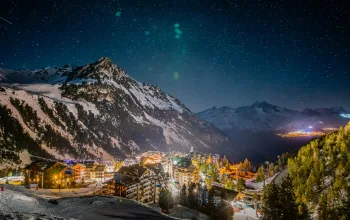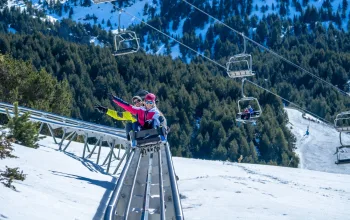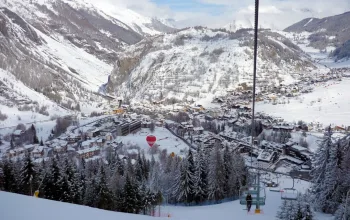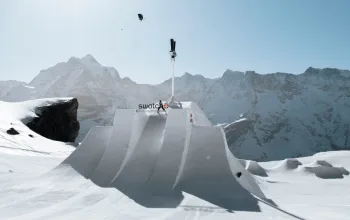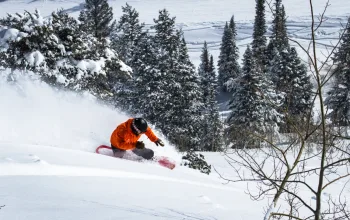I know I’m in the right place, because the sat nav says so, and anyway, there’s nothing else on the horizon, but, on the final approach along the snow-free road out of the nearby town of Beaupre, a rising sense of anti-climax is forming the question: ‘Is this it?’
Despite the lowered expectations, the next bit is easy. I park almost next to the ski shop and ticket office, collect boots and skis and walk the 50 metres to the four-man Express chair that goes up the right-hand of the resort’s south side, the Versant Sud. I glide over the spruce tops, then exit stage left. I turn to look back the way I came – and spend the next five minutes gazing in utter amazement.
The views up here are absolutely stunning – a widescreen panorama of the partly frozen St Lawrence stretching from upriver in the East out towards the sea. It’s truly breathtaking and almost too much to take in, but is the more magnificent for being so totally unexpected.
Eastern Canada, and specifically, the region of Quebec, has not loomed large on UK skiers’ ‘to do’ list, aside from being a popular destination for school parties and gap year kids. Perhaps because it doesn’t exactly loom much in the first place, most skiers crossing the Atlantic are more likely to fly overhead as they head out west to the Rockies. We do have a thing about altitude in this country, worrying that unless we ski down from at least 2,000 metres, we’ll be slithering in slush. But when sea level is a frozen waterway, 800 metres above it is plenty of vertical drop.
Broadly speaking, the east side consists of a handful of bigger ‘bumps’ and a variety of smaller ones. Most – including the main resorts of Mont-Sainte-Anne, Stoneham and Le Massif - are within an hour’s drive of Quebec City, a 400-year-old town steeped in history, topped by green copper roofs and stuffed full of bars and restaurants. It’s a great base for an ‘urban’ ski break.
More of Quebec later: around four hours to the west is the other main regional resort of Tremblant, which is where my Canadian road trip begins...
FIRST STOP: TREMBLANT
There was a moment when I thought I wouldn’t make it out of Montreal airport. I picked up a hire car and the agent helpfully programmed my complimentary sat nav with the address 90 minutes away in Tremblant. Except somehow he didn’t and as I drove away from arrivals I twice found myself re-routed back to the airport. I huffily turned off sat nav lady’s constant refrain of ‘recalculating’ and followed the road signs until I was sure I was headed towards the Laurentian hills (sorry, I just can’t bring myself to call them mountains). I made my peace with sat nav lady and reprogrammed her. Not that she had much to say by now, as it’s a long empty road north.
As I was to discover, first impressions are not always the ones you leave with, but in the case of Tremblant, I thought I’d arrived in a theme park, and I still feel that way. To anyone used to authentic alpine villages, Tremblant is like stepping into a Disneyworld version of what a ski resort should look like.
Skiing first began here in 1939, luring Montrealers with its single chairlift and lodge, but it was just 20 years ago that Intrawest took it over and invested millions in new lifts, snow-making equipment and a whole pedestrianised village, modelled on part of old Quebec. The red, green and blue roofed cluster of hotels, bars, shops, condos and restaurants is certainly cute. It just feels a little artifi cial – a feeling that grows as I learn that the unreliability of natural snowfall in this tundra-like region means the resort relies heavily on the stuff made by its Avalanche snow-making system, which uses more than 1,000 cannons.
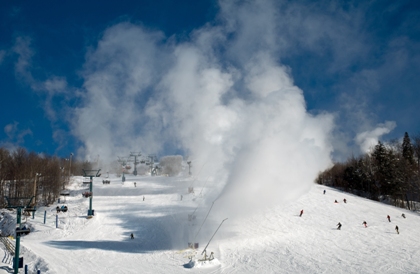
Unfortunately, that’s the harsher ice crystal variety, and for the two days I skied here in March, many of the runs were hard and judderingly unforgiving.
That said, despite this being just one 875-metre mountain in the wilderness, there is a good variety of terrain, more than enough to keep any level of skier happy for a few days – as long as it all stays open! The 14 lifts feed 95 pistes, 19 of them green, 30 blue, 36 single black diamond (roughly on a par with European reds), and 10 double black, including some steep moguls and oldfashioned skiing through trees (mostly off the side of the hill called The Edge). There are also three snow parks where tricksy types can practice their skills.
Views from the top are impressively panoramic – and mostly take in undulating boreal forests and the Lac du Tremblant. But given what came later, I was glad I started rather than ended here!
Queues can be lengthy when the crowds come up for the weekend, and the day is not that long. General skiing starts at 8.30am and lifts shut around 3.30pm – a bit sharp if you’ve paid $56 for a half-day pass, which starts at noon. An adult full-day pass is $75 – still steeper than most of the slopes, but there are plenty of deals that bring the prices down. A bonus for those staying in-resort (I was at the comfortable 69-room L’Ermitage du Lac) is the free First Tracks pass (otherwise another $21) which will get you up the mountain at a chilly 7.45am.
Which was how, on day three, I found myself on the first gondola out of Tremblant. Impressively, my fellow earlymorning skiers were all old codgers – well, you know how hard it is to get teenagers up in the morning – and no-one seemed bothered that we wouldn’t actually be carving new tracks in real fresh powder. It’s just a way of getting on piste early and having a run or two to yourself on the north side. Here, the single blacks Duncan, Geant and Sauté- Moutons particularly got my vote, while on the south side I loved McCulloch, Grand Prix and Laurentienne, but found Kandahar a tad fi erce on the day. A bit of sun did soften things up, so much so that coming back down to the village via the broad slopes of Johannsen, I found a mass of mushy moguls and treacherous spring-like conditions. Yuk. You’re almost better off fi nishing with the placid green run of Nansen Bas... Poignantly, this is where the actress Natasha Richardson hit her head on the ground and died. It’s an innocuous spot. Such a tragic accident.
For the après-lover Tremblant has a lot going for it. And it has to be said that sitting in the Place Bernard main square, swigging a Moosehead beer and catching the last rays of the sun, I didn’t see any miserable faces. People here looked like they were having a good time. My visit coincided with the Sikwam spring festival which takes place over four weekends in March/April and combines live bands, food-tasting and competitions, so the place felt very lively. My après-tip: the microbrewery Le Diable – lovely red beer and a passable fi sh and chip supper you won’t pay through the nose for.
STOP TWO: QUEBEC
Allow four to five hours for the drive from Tremblant to Quebec, I was told, and I was quite looking forward to the road trip. But once I’d left the rolling Laurentian country and was on the main highway from Montreal to Quebec, my outlook flattened with the landscape. To the horizon on one side lay flat farmland, the skyline occasionally broken by a church tower or brightly coloured roof (they do love their paint pots here, but magnolia gets very short shrift). On the other side lay the St Lawrence, but a thin strand of trees meant you couldn’t see it. And nothing worth listening to on the car radio. Tip: if you hire a car here, take your favourite CDs. Dull, dull, dull.
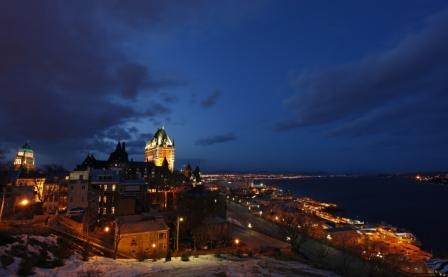
If the lifeless drive sank my spirits, Quebec, the capital of this French-speaking region, lifted them again. Ignore the industrial outskirts; once you reach the centre you find a city full of character and history. This was the town famously fought over by the French and the British, in which forces led by General Wolfe defeated the French general Montcalm on the Plains of Abraham (now a park used in winter by cross-country skiers). Mostly though, Quebec, particularly the old city, a UNESCO World Heritage Site, is a fine walking town with some quirky architecture, loads of bars and restaurants, an interesting artists’ quarter – reached by funicular, or, once a winter, by skateboarders on a purpose-built run weaving down through the ancient buildings (see the Red Bull run on YouTube) - and stores ranging from high-end to tacky moose-themed souvenir shops. It also has strong links with the Cirque du Soleil – which stages a free performance, Les Chemins Invisibles, here each summer.
From a seventh-floor room at the Courtyard Marriot, I looked out over the floodlit roofs of Quebec. It had served as a stopover, but I’d happily have made it a base for the next couple of nights at least.
STOP THREE: MONT-SAINTE-ANNE
With Tremblant having been voted the number one ski resort in eastern North America by the readers of a US ski magazine, my lowered expectations were that I’d seen the best already. And that short drive from Quebec to my next resort didn’t set my pulse racing.
Everything changed once I’d shuffled from the chair lift to the top of my first MSA piste, and seen just where I was. There is nothing to match the majesty of the grand alps on a clear day, but this astonishing wide-angle vista was something totally different and unexpectedly wonderful.
From nearly every piste on the south slope you get the same incredible views of the St Lawrence and Orleans island in the middle of it. But, more of a surprise, and even more enjoyably, here was real snow – lots of it and in great condition, virtually from top to bottom. I had two days at MSA and the skiing there was fabulous – with fresh snow falling on day two, I had ungroomed powdery blacks, and, wide-open cruising blues to play on and all without the crowds I’d encountered at Tremblant. This was worth coming for.
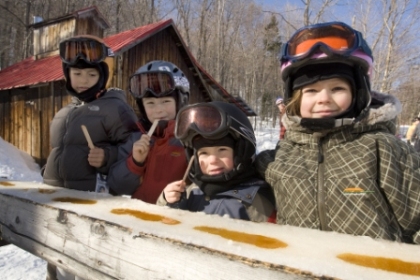
My guide was a 71-year-old veteran called Roger Lamontagne, who knew every inch of the mountain and told me where to ski at different times of the day. The best skiing is on the north side, where the snow stays beautifully pliable till the last lift. And by far the most staggeringly scenic run is La Crete, right to one side of the southern slope. At the top the trees fall away and you seem to be skiing in mid-air. The Canadian poet Felix Leclerc once wrote: ‘My country’s not a country, it’s winter.’ With snow this good you’d apply for citizenship.
MSA gets around 450,000 visitors a year and understandably most are local Quebecois: it’s just so convenient. (Imagine travelling 30 minutes from the centre of London – you might just reach the snowdome at Hemel Hempstead.) Of the small number who do come here from the UK, most are school parties – about 2,000 youngsters a year for the past 15 years - and you can see why. MSA has safe sight lines, all routes down lead to a lift and there are other activities such as dog-sledding, snowshoeing and snowmobiling. However, MSA is currently in negotiation with a couple of big UK operators for winter 2012, so watch this space.
If they set things up, I hope they show a little imagination and try to show visitors more than one resort. For as good as the skiing was at MSA, when the lifts closed at around 4pm, that was it. The place went dead. I went to my hotel, the very comfortable 4-star Val des Neiges, but the bar was deserted and barely half a dozen tables were occupied for dinner. The sauna wasn’t working and the indoor pool was cold. Anyone would think it was the end of the season. Oh..
STOP FOUR: LE MASSIF
I’d given little thought so far to my last stop – Le Massif in Charlevoix, another 40km further up the shoreline, but in an empty hour on my last night in Beaupre, I looked it up. This is a resort with big plans, backed by a massive $230million investment by Cirque du Soleil co-founder Daniel Gauthier, who sold his stake in the circus and is pumping big bucks into making Charlevoix a year-round destination, designed on sustainable principles, with an emphasis on renewable energy and human-scale development, in keeping with its priceless status as a UNESCO Biosphere Reserve.
The visionary project – called Le Projet - includes a bioclimatic hotel, La Ferme, in nearby Baie-Saint-Paul (where the Cirque had its humble origins as a stiltwalking show), chalets on stilts, wind homes clinging to the side of the peak and a new scenic train link from Quebec to Le Massif and on to Malbaie, further up the coast. The train started services last summer. The project is set to be completed in 2013.
Nothing of this was evident as I approached Le Massif by road. In fact I drove past the entrance and had to u-turn. From the main road, a 5km drive past high heaps of snow took me not to the base of the resort, but to the summit, this is a startlingly different prospect compared with Mont-Sainte-Anne or Tremblant.
Le Massif has a 770-metre vertical drop – the highest east of the Rockies – and skiing here is like skiing down a cliff-face, as you plummet right to the shoreline of the St Lawrence itself. Here again, the scenery is immense; the river is wider and it seems as if it swallows you up.

My views were short-lived, however, as it began to snow and never stopped throughout what became a blissful day of skiing in shin-deep powder, accompanied by my guide, Denys, a 67-year-old former Giant Slalom skier, who whizzed away like a whippet on his silver skis. I skied faster than I had ever done before but still couldn’t even get close to him. Exhilarating. The contrast with my fi rst day back in Tremblant could not have been greater. From hard, icy runs to soft, swishing powder that made me feel I was fl oating. Yes, yes, yes. Le Massif also seemed to have the balance right between rest and play: its summit restaurant served healthy, wholesome food – nothing fried, no junk! And its bar offered live music and a place to sink a couple of beers after easing off the boots for the last time.

My views were short-lived, however, as it began to snow and never stopped throughout what became a blissful day of skiing in shin-deep powder, accompanied by my guide, Denys, a 67-year-old former Giant Slalom skier, who whizzed away like a whippet on his silver skis. I skied faster than I had ever done before but still couldn’t even get close to him. Exhilarating. The contrast with my fi rst day back in Tremblant could not have been greater. From hard, icy runs to soft, swishing powder that made me feel I was fl oating. Yes, yes, yes. Le Massif also seemed to have the balance right between rest and play: its summit restaurant served healthy, wholesome food – nothing fried, no junk! And its bar offered live music and a place to sink a couple of beers after easing off the boots for the last time.
I’d happily have spent more time here exploring the 52 pistes, especially as the sun came out the next day. But after a last night spent in the homely, nautically-themed Auberge de l’Ancrage, in Baie-Saint-Paul, a cute small town full of art galleries, smart bars and restaurants, I drove back to Quebec for a last look round the town and a spot of vital shopping before dropping the now-fi lthy rental car at Quebec airport from where I caught a short connecting fl ight to Montreal and thence home.
EPILOGUE
It’s understandable that UK skiers contemplating the Atlantic crossing will fi rst think of the epic resorts of the West. And admittedly, it would be crazy to make the trip to the East of the country and just scratch one little pimple on the landscape. But it’s only four to fi ve hours time difference from the UK and there’s little jet lag to worry about. And if you fancy combining highly accessible skiing with serious downtown nightlife, Quebec makes a good base. And consider a road trip – it’s easy to get around and nearly every day will be different...
Snow how
EAST CANADA
Way to go
Roger fl ew to Montreal via Air Canada. Flights from £423 return,
He stayed…
at L’Ermitage du Lac in Tremblant,
at the Courtyard Marriott in Quebec,
at the Hotel Val des Neiges in Beaupre,
and at Auberge de l’Ancrage in Baie- Saint-Paul,
Car hire, which you can arrange before you go,
Need to know
Quebec City Tourism,



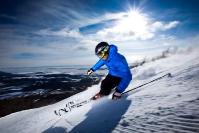 Think Canada and you think Rockies and waist-deep powder. Think Eastern Canada and tumbleweed will waft through your mind. The region just doesn’t figure for most skiers raised on a diet of mighty Alps and wooed by transatlantic sirens calling us to the legendary snowfields way out west. And, cruising up to one of Canada’s major Eastern resorts, Mont-Sainte-Anne, I can’t help wondering if I’ve got off the plane about 1,800 miles too early.
Think Canada and you think Rockies and waist-deep powder. Think Eastern Canada and tumbleweed will waft through your mind. The region just doesn’t figure for most skiers raised on a diet of mighty Alps and wooed by transatlantic sirens calling us to the legendary snowfields way out west. And, cruising up to one of Canada’s major Eastern resorts, Mont-Sainte-Anne, I can’t help wondering if I’ve got off the plane about 1,800 miles too early.